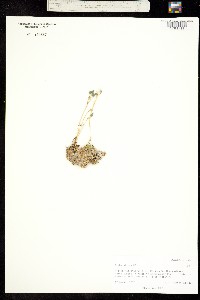Draba pilosa
|
|
|
|
Family: Brassicaceae
Tundra Whitlow-Grass
|
Perennials; (not stoloniferous); caudex branched (covered with persistent, dry leaves and midveins); scapose. Stems unbranched, 0.4-1.7 dm, glabrous or pubescent, trichomes simple, 0.2-0.9 mm, and fewer, 2-4-rayed, 0.1-0.6 mm. Basal leaves (imbricate); rosulate; petiolate; petiole (base thickened), ciliate throughout; blade linear to linear-oblanceolate, 0.5-1.5(-2.2) cm × 1-2.5(-4) mm, margins entire (thickened, ciliate, trichomes simple and 2-rayed, to 1.1 mm), surfaces pubescent, abaxially with simple trichomes, 0.3-1 mm, and 2-4-rayed ones, 0.1-0.5 mm, adaxially similar, or with only simple trichomes, (midvein prominent, thickened). Cauline leaves 0. Racemes (2-)4-12-flowered, ebracteate, usually elongated in fruit; rachis not flexuous, glabrous or pubescent as stem. Fruiting pedicels divaricate-ascending, usually straight, rarely curved upward, 6-13 mm, glabrous or pubescent as stem. Flowers: sepals ovate, 2-3.5 mm, pubescent, (trichomes simple and short-stalked, 2-rayed); petals pale to bright yellow, obovate, 3.5-6 × 2-3.5 mm; anthers ovate, 0.4-0.5 mm. Fruits elliptic to lanceolate, 5-11 × 3-4 mm, plane, flattened; valves glabrous or puberulent with simple and short-stalked, 2-rayed trichomes, 0.07-0.3 mm; ovules 12-20 per ovary; style 0.4-0.9 mm (stigma about as wide as style). Seeds ovoid, 1.2-1.4 × 0.8-1 mm. Flowering Jul-Aug. Dry gravelly slopes, sandy places, wet tundra; 0-1300 m; N.W.T., Nunavut, Yukon; Alaska; e Asia (ne Russian Far East, n Siberia). O. E. Schulz (1927) reduced Draba pilosa to a variety of the decaploid D. alpina and cited North American collections. The former species was not listed by C. L. Hitchcock (1941) or R. C. Rollins (1993). From D. alpina, D. pilosa is easily distinguished by having strongly thickened and persistent (versus not thickened) midveins and margins, and usually narrower leaf blades [1-2.5(-5) versus 2.5-6(-9) mm wide]. As recognized herein, Draba pilosa is broadly circumscribed to include perhaps two or three closely related taxa. All are scapose plants with large, yellow flowers and prominent, persistent midveins and petioles. Some Alaskan forms (e.g., Parker 7596, ALA), which grow in moist heath habitats, have leaves 3-5 mm wide, whereas the majority have narrower leaf blades rarely reaching 2.5 mm in width. Most plants assigned to this species have leaves with exclusively simple trichomes and often glabrous scapes. Others (e.g., Chesemore & Davies 13, Murray 3371, Parker & Batten 8954, all at ALA) have leaf blade surfaces and scapes with 2-4-rayed trichomes and blade margins ciliate with simple trichomes. One collection (Walker s.n., ALA) has a mixture of plants of both trichome types but no intermediates were found. Detailed molecular and cytological studies are needed on this complex to determine if more than one taxon is represented.
|




































































































